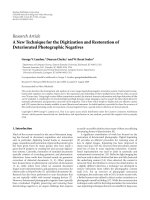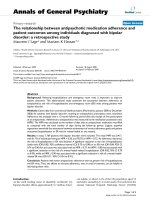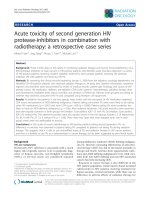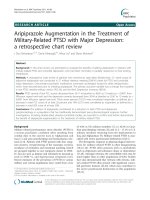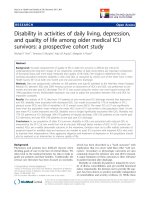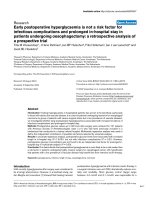Dimensional Changes In The Supporting Tssues Following Immediate Placement And Restoration Of Dental Implants In The Aesthetic Zone: A Retrospective Study
Bạn đang xem bản rút gọn của tài liệu. Xem và tải ngay bản đầy đủ của tài liệu tại đây (1.77 MB, 123 trang )
Dimensional changes in the supporting tissues following
immediate placement and restoration of dental implants in the
aesthetic zone: a retrospective study
Nabil Omar Khzam
BDSc
School of Dentistry and Oral Health
Griffith Health
Griffith University
Submitted in fulfilment of the requirements of the degree of
Master of Philosophy
March, 2010
ABSTRACT
Aim: The objective of this retrospective study was to assess the survival rate and the hard and
soft tissue response following immediate placement and provisional restoration of singletooth implants in the aesthetic zone.
Materials and Methods: Thirty-four patients (13 male and 21 female) with 37 immediately
placed and restored implants (Astra-Tech® AB, Mölndal, Sweden) were identified as eligible
to participate in this retrospective study. Thirteen of these patients returned for the follow-up
examination. All participating patients underwent the same treatment strategy which was
removal of the failed tooth, flapless surgery, immediate implant placement and the
connection of a screw-retained temporary restoration. Reasons for tooth loss included failed
root canal treatment, trauma and tooth resorption. Three months following implant
placement, the temporary crowns were replaced by the definitive restorations. Implant
survival rates and hard and soft tissue changes were measured using photographs and periapical x-rays. The range of observation period was between 12 to 27 months with a mean
period of 16 ± 5 months.
Results: At 16 ± 5 months, all implants were present at the time of follow-up with no
complications, resulting in an implant survival rate of 100%. Radiographic evaluation
revealed that there was no statistical difference in bone loss mesially and distally between
baseline and follow-up. Clinical evaluation of the soft tissue revealed no statistically
significant changes in mesial papilla, distal papilla and mid-facial tissue stability throughout
the observation period.
Conclusions: Within the limitation of this retrospective study, immediate implant placement
and provisional restoration in the aesthetic zone of the maxilla can result in acceptable
treatment outcomes as well as stable peri-implant tissues after a follow up period of 16 ± 5
months using the Astra Tech implant system.
This work has not previously been submitted for a degree or diploma in any university. To
the best of my knowledge and belief, the thesis contains no material previously published
or written by another person except where due reference is made in the thesis itself.
Table of contents
LIST OF ILLUSTRATIONS ………………………………………1
LIST OF TABLES…………………………………………………..2
ACKNOWLEDGEMENTS................................................................4
1.0
INTRODUCTION……………………………………………5
1.1
OVERVIEW……………………………………………….....5
1.2
RESEARCH QUESTION……………………………………6
1.3
SIGNIFICANCE OF THE CURRENT STUDY.…..……….6
1.4
OBJECTIVES OF THE CURRENT STUDY………..……..7
2.0
LITERATURE REVIEW…………………………………....8
2.1
TERMINOLOGY…………………….………………………8
2.2
HISTORICAL BACKGROUND OF IMMEDIATE
IMPLANT PLACEMENT AND RESTORATION…….....10
2.3
IMMEDIATELY PLACED AND RESTORED IMPLANT
COMPARED WITH DELAYED IMPLANT
PLACEMENT…......................................................................11
2.4
LIMITATION OF THE IMMEDIATE IMPLANT
PLACEMENT AND RESTORATION STRATEGY……...12
2.5
REVIEW OF THE LITERATURE AND SEARCH
STRATEGY……………………………………………….....14
2.5-1 SURVIVAL RATE OF IMMEDIATELY PLACED AND
RESTORED IMPLANTS IN THE AESTHETIC
ZONE…………………………………………………………18
2.5-2 SOFT TISSUE CHANGES FOLLOWING IMMEDIATE IMPLANT
PLACEMENT AND RESTORATION...................................29
2.5-3 HARD TISSUE CHANGES FOLLOWING IMMEDIATE
IMPLANT PLACEMENT AND RESTORATION……......39
3.0
MATERIALS AND METHODS …………………………...46
3.1
PATIENT SELECTION (THE INCLUSION
CRITERIA……………………………………………………46
3.2
SURGICAL PROTOCOL AND TECHNIQUES…………..47
3.3
TEMPORARY CROWN PLACEMENT…………….…......51
3.4
PERMANENT CROWN PLACEMENT...…………….........53
3.5
HARD TISSUE MEASUREMENTS…………………….….54
3.6
SOFT TISSUE MEASUREMENTS………………………...56
3.7
OTHER MEASUREMENTS………………………………..59
3.7-1 IMPLANT SURVIVAL RATE……………………………...59
3.7-2 ASSESSMENT OF INTERDENTAL PAPILLA…………..60
3.7-3 PLAQUE LEVELS ……………………………………….....60
3.7-4 GINGIVAL TISSUE BIOTYPE……………………………60
3.8
STATISTICS USED IN THE STUDY……………………...60
4.0
RESULTS…………………………………………………….62
4.1
PARTICIPANTS ENROLMENT AND
DEMOGRPHICS......................................................................62
4.2
HARD TISSUE PARAMETERS…………………………....65
4.3
SOFT TISSUE PARAMETERS…………………………….70
4.4
JEMT S’ INDEX……………………………………………..75
4.5
PRESENCE OF PLAQUE.......................................................75
5.0
DISCUSSION…………………………………………………76
5.1
PATIENT ENROLMENT………………………………...…76
5.2
IMPLANT SURVIVAL RATE…………………………...….77
5.3
HARD TISSUE MEASUREMENTS…………………….......79
5.4
SOFT TISSUE MEASUREMENTS……………………........82
5.5
PLAQUE LEVELS……………………………………….......91
5.6
GINGIVAL TISSUE BIOTYPE…………………………….92
5.7
FUTURE CONSIDERATIONS……………………………..92
6.0
CONCLUSIONS………………………………………….......94
7.0
LIST OF REFERENCES…………………………………….95
LIST OF ILLUSTRATIONS
Figure 1 Surgical techniques- failed tooth before extraction………………………49
Figure 2 Surgical techniques- tooth extraction…………………………………….50
Figure 3 Surgical techniques- implant secured in place…………………………....50
Figure 4 Temporary crown placement………………………………………………51
Figure 5 Temporary crown placement………………………………………………52
Figure 6 Temporary crown adjustment…………………………………………….52
Figure 7 Permanent crown placement- 3 months postoperatively.....................……53
Figure 8 Permanent crown placement- 6 months postoperatively …….…………..53
Figure 9 Illustration of hard tissue measurements on periapical x-ray…………….55
Figure 10 Illustration of the measurements of the soft tissue on photographs……..58
Figure 11 Level of mid-buccal gingiva at placement of temporary restoration……85
Figure 12 Level of mid-buccal gingival at the follow-up………………………….86
Figure 13 Level of mesial papilla at the placement of the temporary restoration….89
Figure 14 Level of mesial papilla at the follow-up……………………….………..89
1
LIST OF TABLES
Table 1 Selected studies reporting on immediately placed and provisionally restored single
maxillary implants in the aesthetic zone………………………………………………….17
Table 2 Implant survival rates for immediately placed and restored implants in the aesthetic
zone………………………………………………………………………………….........28
Table 3 Reported soft tissue dimensional changes following immediate implant placement
and restoration in the aesthetic zone………………………………………….…..............38
Table 4 Reported hard tissue dimensional changes following immediate implant placement
and restoration in the aesthetic zone……………………………………………..….........45
Table 5 Tooth types and reason for tooth extraction…………………….........................64
Table 6 Overview of clinical data………………………..................................................64
Table 7 Bone level changes (presented as percentage change)……………......................65
Table 8 Frequency analysis of hard tissue changes (mesial measurement in
millimetrs)...........................................................................................................................66
Table
9
Frequency analysis
of
hard
tissue
changes
(mesial
measurement
in
percentage)..........................................................................................................................67
Table 10
Frequency analysis
of hard tissue changes
(distal
measurement in
millimetrs)...........................................................................................................................68
Table 11
Frequency analysis
of hard tissue changes
(distal
measurement in
percentage…………………………………………………………………………….......69
2
Table
12
Soft
tissue
level
changes
(presented
as
percentage
change)...............................................................................................................................70
Table 13 Frequency analysis for mesial papilla change in percentage..............................71
Table 14 Frequency analysis for distal papilla change in percentage................................72
Table 15 Frequency analysis for mid-facial change in percentage....................................73
Table 16 Changes in soft tissue levels in millimetres.........................................................74
Table 17 Changes in the interdental papilla.......................................................................75
Table 18 Implant survival rates, as reported in studies using similar treatment
protocol...............................................................................................................................78
Table 19 Changes in hard tissue (mesially and distally) as reported in published
studies.................................................................................................................................81
Table 20 Changes in soft tissue levels (mid-buccal aspect) as reported in published
studies………………………………………………………………………………….....87
Table 21 Changes in soft tissue (mesial and distal papillae) as reported in published studies.
………………………………………………………………………………….…………90
3
ACKNOWLEDGEMENTS
I wish to express my warm appreciation and thanks to:
Prof. Saso Ivanovski, for his continued guidance and commitment toward this
research project
A/P. Nikos Mattheos, for his kind assistance and professionalism in allowing
me to move forward with my research project
A sincere acknowledgment goes to my wife, Dr Sondus Abuoun for her
extraordinary understanding, selfless efforts and genuine friendship
My sponsor, the Libyan embassy in Canberra, with special thanks to Dr. Omran
Zoud and his staff for the enormous support
Sir Geoffrey Cresser for his help in the proof reading and editing of this thesis
Mrs Joy Robertson and Ms Leanne Pockley, for their daily help and assistance
Finally, I would like to dedicate this thesis to my parents
4
1.0 Introduction
1.1
Overview
Dental implants are metal structures inserted into alveolar bone in order to facilitate
the replacement of missing teeth. They are manufactured from titanium, which is highly
biocompatible and has a unique ability to integrate with bone, forming an irreversible bond.
This phenomenon is known as osseointegration. Following implant placement, a period of
time is required for Osseo integration and the implant is subsequently restored with a
prosthesis which has a similar appearance and functionality to natural teeth. The use of dental
prostheses supported by implants has become a widely utilised treatment option for tooth
replacement. This treatment modality has demonstrated favourable outcomes in terms of long
term prosthetic success as well as quality of life outcomes for patients.
Osseointegration was first described by Brånemark [1], who defined it as a direct
connection between living bone and a load-carrying endosseous implant, as observed at the
light microscopic level. Subsequently, osseointegration was defined as a direct structural and
functional connection between living bone and the surface of a load-bearing implant [2].
The original implant placement protocol involved a load free period after implant
placement of 3 and 6 months in the mandible and maxilla respectively [3]. It was postulated
that a load free period would assist in minimizing micromotion, thus reducing the possibility
of fibrous tissue formation or encapsulation and providing an environment conducive to
osseointegration [4].
5
The original ‘Branemark protocol’ also involved placement of the implant following
complete healing of the tooth extraction socket. The implant was then left to heal for six
months prior to prosthesis attachment in order to allow for osseointegration to occur [2].
During this healing period, the implant was submerged under the oral mucosa, necessitating a
second surgical procedure to expose it, which was followed by a period of soft tissue healing
prior to construction of the prosthesis. Although this treatment protocol demonstrated good
survival rates, it was also very lengthy.
With the increased popularity of dental implants, demand has grown for treatment
completion in a shorter period of time compared with the original ‘Branemark protocol’. This
has led to the introduction of new surgical and prosthetic protocols. One such technique
involves the immediate insertion of the implant at the same time as tooth extraction
(immediate implant placement) and subsequent restoration of the implant with a provisional
prosthesis within 24 hours (immediate restoration). This treatment protocol is most likely to
be utilised in the aesthetic zone of the patient’s dentition involving the anterior maxillary
teeth [5].
1.2
Research question
The research questions are:
1) What is the survival rate associated with this clinical procedure?
2) What are the soft and hard tissues dimensional changes associated with
immediately placed and restored implants in the aesthetic zone?
1.3
Significance of the current study
6
The assessment of clinical outcomes associated with immediately placed and restored
implants in the aesthetic zone will provide vital information to the clinical practitioner
regarding this increasingly popular treatment modality.
1.4
Objectives of the current study
The objectives of the current study were to retrospectively assess the survival rate, as
well as soft and hard tissue dimensional changes associated with immediately placed and
restored implants replacing single teeth in the aesthetic zone after a minimum follow up of 12
months.
7
2.0 LITERATURE REVIEW
2.1
Terminology
There has been inconsistency in the use of the key terms “immediate placement”,
“immediate loading” and “immediate restoration” in the literature. Various authors have
defined the terms differently leading to misinterpretation of results and miscommunication of
outcomes. For instance, a number of authors [4] define “immediate loading” as any
restoration that is visible in the oral cavity even if it does not have any occlusal contact with
the opposite dentition. They argue that lip and cheek pressure, as well as tongue movement
and food particles coming into contact with the implant will place a load on the implant, and
hence the definition of immediate implant loading should apply. Furthermore, they consider
that flexure stress and strain occurring in the jaw during opening and closing movement of
the mouth generates functional loads on implants even when they are not in direct occlusal
function [4]. Therefore, due to this discrepancy it is important to outline the terms and
definitions which clearly differentiate between different clinical implant loading and
placement protocols. Cochran et al [6] defined the various loading protocols as follows:
Conventional loading: Defined as the restoration of implants after a healing
period of 3 and 6 months in the mandible and maxilla respectively.
Immediate restorations: Defined as any restoration placed within 48 hours of
implant insertion but with no contact with the opposite dentition in both
centric and eccentric occlusion. The rationale behind the 48 hour window is
not based on any biological consideration but is purely related to the
practicality and logistics associated with the ability to perform the restorative
placement at the same setting as the surgical implant placement (which is not
8
always possible).
Immediate loading: Defined as the placement of the restoration in direct
contact with the occlusal plane of the opposing teeth within 48 hours of
implant insertion.
Early loading: Defined as the placement of a restoration in direct contact with
the opposite dentition more than 48 hours, but less than three months, after
implant insertion.
Delayed loading: Defined as the delivery of the prosthesis some time after the
conventional healing period of three and six months in the mandible and the
maxilla respectively.
Recently, a modification of the above definitions [6] has been recommended [7]:
Conventional loading of dental implants is defined as the restoration of the implant
more than 2 months after implant placement.
Early loading of dental implants is defined as loading between 1 week and 2 months
following implant placement.
Immediate loading is defined as being less than 1 week following implant placement.
A separate definition for delayed loading was no longer considered necessary.
In terms of implant placement protocols, the following classification can be utilised
[8]:
Type 1 or “Immediate implant placement”: The implant is placed immediately
following tooth extraction.
9
Type 2: Implant placement 4 to 8 weeks after tooth extraction to allow
complete soft tissue coverage of the tooth socket.
Type 3: Implant placement 3 to 4 months after tooth extraction to allow
substantial bone fill to occur within the tooth socket.
Type 4: Implant placement more than 4 months after tooth extraction to allow
complete healing of the tooth socket.
This retrospective study focuses on the clinical protocol of immediate implant
placement (type 1) into fresh extraction sockets immediately following tooth extraction, and
immediate provisional restoration of this implant. A follow up period of a minimum of 12
months was chosen as changes in soft and hard tissue dimensions can continue during the
period of wound healing and maturation, thus affecting the aesthetic outcome and level of
patient satisfaction.
2.2
Historical background of immediate implant placement and
restoration
Several investigators have investigated the clinical outcomes resulting from
immediate implant placement and/or restoration of dental implants. The concept of
immediate implant placement (without restoration) was introduced by Lazzara [9] in 1989,
with the rationale of reducing treatment time. Subsequently, Gomez et al [10] in 1997
reported a 98.84% five year success rate in eighty three implants placed immediately after
tooth extraction without immediate restoration.
In terms of immediate restoration of implants, Tarnow et al [11] in 1997 reported a
10
97.1% success rate using a protocol that involved the placement of implants in healed sockets
in both jaws and immediately restoring them without any contact in both centric and eccentric
occlusion. In 1998, Wohrle [12] was the first clinician who used immediate implantation in
fresh extraction sockets in the anterior area of the maxilla and placed a temporary crown
immediately after surgery. The outcome of this study was a 100% success rate in fourteen
patients and acceptable aesthetic outcome was reported.
2.3
Immediately placed and restored implant compared with
delayed implant placement
The traditional implant placement protocol, where the implants are inserted into the
completely healed socket, has shown a high clinical survival rate. However, efforts have now
focused on improving the aesthetic outcome of implant therapy, especially in more
demanding aesthetic circumstances. The immediate implant placement and immediate
restoration treatment protocol has been developed based on the rationale that it preserves both
soft and hard tissue architecture around the immediately installed implant. Hui at el [13]
compared implants placed according to the conventional placement protocol with those
placed into extraction sockets and immediately restored. His study concluded that both
groups showed promising initial results in terms of patient satisfaction and aesthetic outcome.
Another study carried out by Guirado at el [14] revealed that immediate implant placement in
fresh single tooth extraction sites followed by immediate restoration with provisional crowns
had high survival rates comparable to the conventional placement protocol. Conversely,
Chaushu et al [15] showed that immediate placement and restoration of single tooth implants
carried a 20% risk of failure. This outcome may be interpreted as being a result of using
press-fit rather than conventional screw type implants. Most recently, Paolantonio et al [16]
11
showed that immediate implant placement minimized post extraction bone resorption, this
maintaining the hard tissue topography close to its original contour before extraction and had
a positive influence on the soft tissue architecture around the restored implant.
In summary, there are several possible benefits of immediate placement compared
with conventional placement. Firstly, there are fewer surgical procedures resulting in less
patient morbidity. Secondly, soft tissue stability around the implant supported restoration is
improved. Thirdly, time is saved as both post-extraction healing and osseointegration events
take place at the same time.
2.4 Limitation of the immediate implant placement and
restoration strategy
Immediate placement and restoration of implants in the aesthetic regions appears to
offer a success rate that is equal to that associated with conventional treatment. However,
case selection is essential and there are several criteria which need to be considered. These
criteria include:
Morphology and configuration of the tooth socket, soft tissue contour is determined
by the underlying bone. Therefore any bone defects will potentially compromise the aesthetic
outcome of the treatment [17], [18], [19], [20], [21] and [22].
Gingival tissue configuration, the gingiva should be of healthy and symmetrical
harmony to allow an aesthetic outcome. Any gingival disease or defect would compromise
the final outcome
12
Gingival tissue biotype, in general, a thick gingival tissue biotype is preferable in the
aesthetic zone as it can mask the metallic hue of the implant neck, as well as being more
resistant to recession. In contrast, the thin gingival tissue biotype is more prone to recession
and tissue discoloration. In these situations, surgical and prosthetic planning before implant
placement is very critical, and the implant may be placed more palatally in order to have a
thicker buccal volume of hard and soft tissue in order to reduce the problem of metal showing
through the tissues [23], [24], [25] and [26].
Smile line, patients with a high smile line who routinely show their gingival margin
are a greater aesthetic risk than patients who don’t show their smile line during speech and
laughter.
Presence of pathology/infection, poor oral hygiene and microbial plaque are causative
factors that result in the occurrence of peri-implant infection and implant loss. Therefore,
evaluation of the oral hygiene of the patient is a mandatory step before commencing
immediate implant placement and restoration [27] and [28].
Smoking, studies show that smoking has a deleterious effect on implant integration in
the short term and on the peri-implant tissue health in the long term. These effects may be
exacerbated in an immediate implant placement and restoration treatment protocol [29], [30],
[31], [32], [33] and [34].
13
2.5
Review of the literature and search strategy
The following criteria were considered in the process of selecting studies of immediate
implant placement and restoration for this review:
1. Types of studies: all longitudinal studies were eligible for inclusion – randomized
controlled trials, controlled clinical trials, cohort studies, case control studies and
consecutive case report series. Only those studies that included 6 patients or more
were selected. A minimum follow up time of 1 year was set as an inclusion criterion.
Only studies published in English were included.
2. Type of treatment modality (intervention): immediate implantation into the fresh
extraction socket followed an immediate placement of a provisional restoration in the
aesthetic zone.
3. Outcomes that were measured:
Implant survival rate.
Patient satisfaction.
Peri implant soft tissue changes.
Peri implant hard tissue changes.
Gingival biotype and its relation to recession.
For this review, a detailed search strategy was used for each selected database in order to
identify all of the articles published in relation to the stated aims of this review. The search
strategy used was a combination of free text terms and MeSH* terms. The searched data
bases were:
14
# PUB MED, EBSCOhost and Ovid arms of MEDLINE.
# CENTRAL (The Cochrane Central Registar of Controlled Trials).
# Science Direct.
The terms used in this search were:
Dental Implants, Oral Implants, immediate placement, immediate restoration, Immediate
Provisionalization, aesthetic, single tooth replacement, single tooth in the maxilla and
extraction socket.
The search strategy was as follows:
(Single Tooth* OR teeth*) AND Maxilla* AND (Immediate OR Immediate placement, OR
Immediate Implantation, OR immediate restoration, OR extraction socket)
Single Tooth* AND Maxilla* AND
Single Tooth* AND maxilla * AND
Single Tooth* AND Maxilla* AND (OR provisionalization)
Single Tooth* AND Maxilla* AND
Furthermore, the search was complemented by checking the references of the selected
articles for additional useful publications. Also a manual search was carried out of the
following major journals in dental implantology: International Journal of Oral and
Maxillofacial Implants, Clinical Oral Implants Research, Clinical Implant Dentistry and
Related Research.
The search strategy initially yielded 80 articles. From these, 17 articles were considered
15
to fulfil the criteria for inclusion in this review. The other studies were excluded for the
following reasons:
1) Review articles (10 articles): [35], [36], [37], [38], [39], [40], [41], [42], [43] and
[44].
2) Implantation into healed sockets only (30 articles ): [45], [46], [47], [48], [49], [50],
[51], [52], [53], [54], [55], [56], [57], [58], [59], [60], [61], [62], [63], [64], [65] ,
[66], [67] , [68], [69], [70], [71], [72], [73] and [74].
3) Implantation in the mandible or maxilla without any differentiation (7 articles): [45],
[46], [52], [56], [59], [74] and [75].
4) Case reports of immediately placed and loaded implants (16 articles): [45], [47], [50],
[52], [53], [59], [76], [77], [78], [79], [80], [81], [82], [83], [84], and [85].
5) The 17 included articles, alongside a description of the study type, implant system
used and the numbers of included patients/implants are outlined in Table 1.
16
Study
Design
Wohrle 12 (1998)
Hui et al 13 (2001)
Guirado et al 14 (2002)
Chaushu et al 15 (2001)
Groisman et al 86 (2003)
Kan et al 87 (2003)
Lorenzoni et al 88 (2003)
Norton 89 (2004)
Tsirlis 90 (2005)
Cornelini et al 91 (2005)
Ferrarra et al 92 (2006)
Kan et al 93 (2007)
Canullo et al 94 (2007)
Hall et al 95 (2007)
Palattella et al 96 (2008)
De Rouck et al 97 (2008)
CS
CS
CS
CS
CS
CS
CS
CS
CS
CS
CS
CS
CS
RCT
CS
CS
No. of
Patient/implant
14/ 14
24/ 24 = 13 & 11*
13/ 18 = 9& 9*
26/28= 14 & 8*
92/ 92
35/ 35
9/ 12 =8 & 4*
25/ 28 =16 & 12*
38/ 43 =28 & 15*
22/ 22
33/ 33
29/ 38 = 23 &15*
9/ 10
28/ 28 =14& 14*
16/ 18 = 9& 9*
30/ 30
Ribeiro et al 98 (2008)
CS
64/82= 46 & 36*
Implant systems
Replace Select
Brånemark
Osseotite 3i
21 Steri-Oss & 7 Alpha Bio
Replace select
Replace Select
Frialit-2
Astra Tech
Osseotite 3i
ITI
Frialit-2
Replace Select
Defcon®
Southern Implants
Tapered effect
Replace select
Connexao sistema de protese
*Delayed implant placement.
RCT, randomized controlled trial; CS, case series.
Table 1
Selected studies reporting on immediately placed and provisionally restored
single maxillary implants in the aesthetic zone.
17
